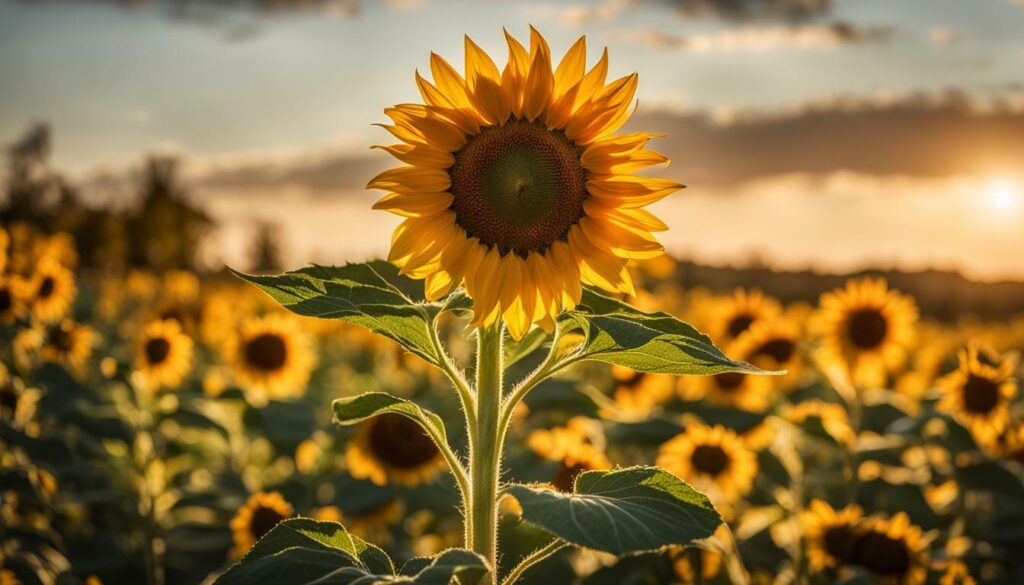Welcome to Tournesol ET Soleil, where the enchanting sunflowers of France reach for the sky, creating a mesmerizing spectacle.
As a journalist, I’ve always been captivated by the beauty and magic of sunflowers. Their vibrant yellow petals and towering heights make them a true masterpiece of nature. In this article, I will take you on a journey through Tournesol ET Soleil, exploring the fascinating world of France’s sunflowers and the secrets they hold.
Did you know that the movement of sunflowers towards the sun is actually a response to light, not the sun itself? This phenomenon, known as phototropism, is controlled by the growth hormone auxin. It causes the bottom of the plant to grow faster than the top, giving the illusion that the sunflower is following the sun throughout the day. However, this movement ceases once the sunflower reaches maturity, as it turns eastward to attract pollinators.
In this article, we will dive deeper into the intriguing journey of sunflowers, exploring their growth process and the science behind their movement. We will also debunk the myth that sunflowers continue to track the sun throughout their lifespan. Additionally, we will uncover the symbolism sunflowers hold in French culture and provide valuable tips for capturing their beauty through photography.
Join me as we explore the golden fields of Tournesol ET Soleil, immersing ourselves in the wonders of France’s sunflower paradise. From the environmental significance of sunflowers to the best locations for sunflower enthusiasts, this article will leave you inspired and in awe of the magic that unfolds in Tournesol ET Soleil.
Experience the Golden Fields of France
Immerse yourself in the breathtaking beauty of Tournesol ET Soleil as you witness the vibrant fields of sunflowers stretching endlessly towards the horizon. France’s sunflower fields, with their golden petals and towering heights, offer a mesmerizing sight that captivates both locals and tourists alike.
As you stroll through the fields, you’ll feel a sense of tranquility wash over you, enveloped by nature’s grandeur. The sunflowers sway gently in the breeze, creating a wave of golden hues that dances before your eyes. The symphony of colors, ranging from vibrant yellows to deep oranges, paints a picturesque landscape that is truly unforgettable.
Whether you’re exploring the countryside or driving along the winding roads, the vastness of the sunflower fields will leave you in awe. The sheer expanse of these golden treasures seems to go on forever, inviting you to wander and lose yourself in their beauty. It’s a sight that evokes a sense of wonder and appreciation for the wonders of nature.
Soaking in the Beauty: Sunflower Photography Tips
If you’re a photography enthusiast, the sunflower fields of France provide an ideal backdrop to capture stunning images. Whether you’re using a professional camera or just your smartphone, here are a few tips to help you make the most of your sunflower photography:
- Timing is everything: Visit the sunflower fields during the early morning or late afternoon to capture the soft, golden light that enhances the beauty of the flowers.
- Experiment with angles: Get down low and capture the sunflowers from a different perspective. Try shooting upwards to showcase the height and majesty of these towering beauties.
- Play with depth of field: Use a wide aperture to create a shallow depth of field, blurring the background and drawing attention to the vibrant sunflowers in the foreground.
- Include human elements: Consider including a person or object in your composition to add scale and create a sense of storytelling in your photographs.
- Respect nature: While capturing the beauty of the sunflower fields, be mindful of your surroundings and tread lightly to preserve the delicate ecosystem.
Remember, photography is about capturing moments and emotions. Let the golden fields of Tournesol ET Soleil inspire you and tell their story through the lens of your camera. The result will be images that not only showcase the beauty of sunflowers but also evoke a sense of wonder and awe in those who view them.
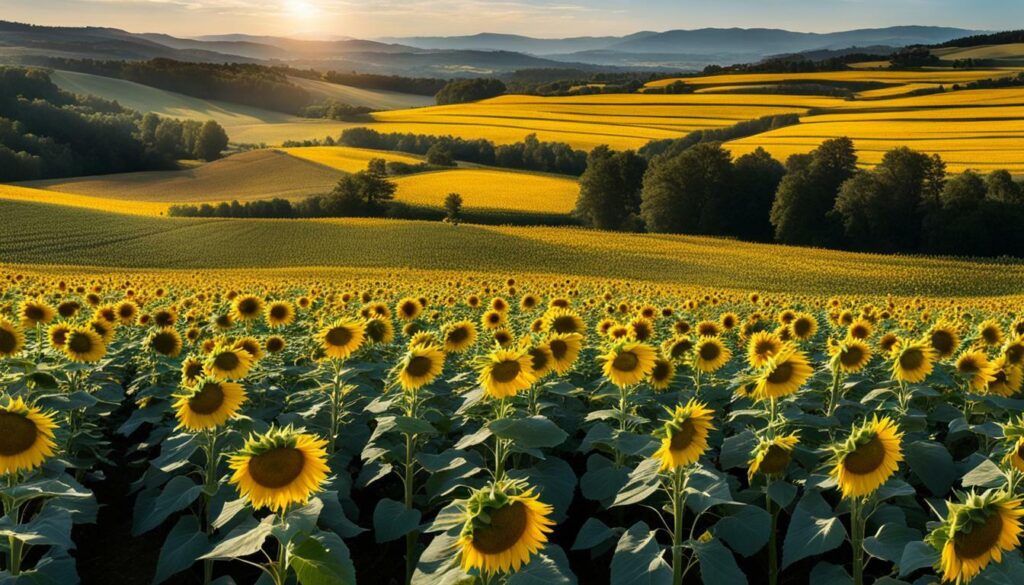
| Location | Best Time to Visit | Area |
|---|---|---|
| Provence | June to August | Valensole Plateau |
| Toulouse | July to August | Gers region |
| Burgundy | July | Yonne department |
The Fascinating Journey of Sunflowers
Discover the captivating journey of sunflowers, from their initial growth stages to their remarkable ability to follow the sun’s radiant rays. The tournesol, or sunflower, is a symbol of beauty and resilience, capturing the attention of admirers worldwide. As these majestic flowers begin their life cycle, they undergo a fascinating transformation that showcases the wonders of nature.
From the moment the tiny sunflower seed is planted, it begins its quest for growth. The seedling emerges from the soil and reaches towards the sky, driven by the desire to absorb the nourishing sunlight. With its roots firmly planted in the ground, the sunflower tilts its vibrant yellow face towards the sun, a phenomenon known as phototropism.
Phototropism is not heliotropism, as commonly believed. While heliotropism implies the sunflower’s ability to follow the sun’s movement, it is actually the sunflower’s response to the light that drives its growth. The plant hormone auxin plays a crucial role in this process. Auxin stimulates cell elongation, causing the lower side of the stem to grow faster and thus bending the plant towards the light.
| Stage | Description |
|---|---|
| Germination | The sunflower seed absorbs water and begins to sprout, sending its roots downwards and stem upwards. |
| Vegetative Growth | The sunflower’s stem and leaves develop, as it continues to grow taller and establish a strong root system. |
| Flowering | The sunflower reaches its peak beauty, with bright yellow petals surrounding its central disk filled with seeds. |
| Maturity | The sunflower stops following the sun and positions itself facing east, attracting pollinators for reproduction. |
However, it is important to note that this movement towards the light is temporary. Once the sunflower reaches maturity, it stops its journey and faces east, positioning itself to attract essential pollinators. Contrary to popular belief, sunflowers do not continue to follow the sun throughout their lifespan.
The fascinating journey of sunflowers, from their early growth stages to the stunning flowering phase, showcases the incredible resilience and adaptability of these remarkable plants. Their ability to respond to the light and attract pollinators highlights their importance in the ecosystem. So, the next time you come across a field of sunflowers, take a moment to appreciate the captivating journey they have undergone and the natural wonders they represent.
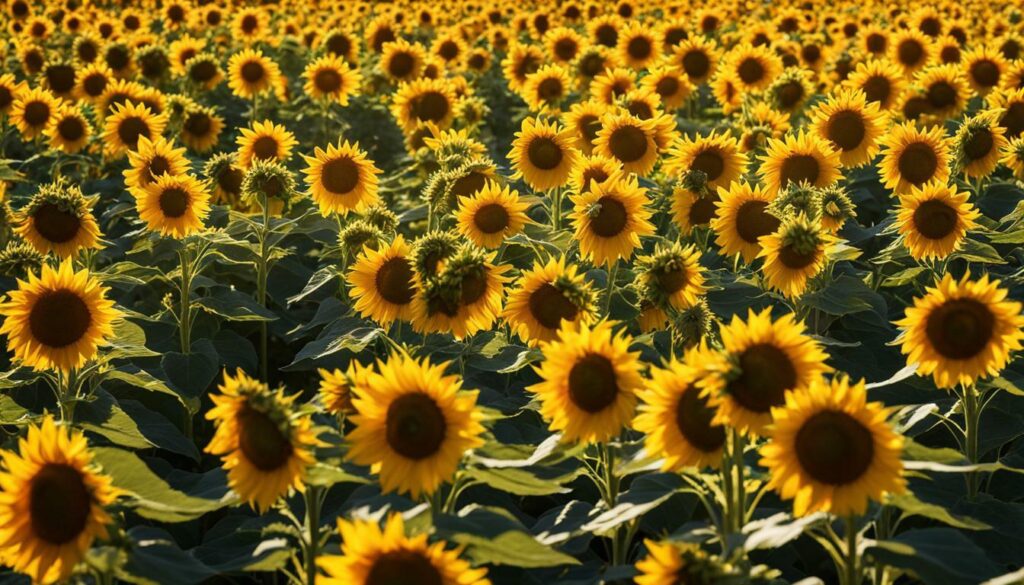
Uncover the scientific wonders of sunflowers as we explore the phenomenon of phototropism and the role it plays in their movement. Contrary to popular belief, sunflowers do not actually follow the sun, but rather move in response to light. This movement is known as phototropism, not heliotropism. The growth hormone auxin is responsible for orchestrating this fascinating dance towards the light.
When a sunflower seed germinates, its shoot begins to grow upwards, while the root grows downwards. As the shoot emerges from the soil, it is highly sensitive to light. The presence of light triggers the production of auxin, which accumulates on the shaded side of the stem. This hormone then stimulates cell elongation, causing the shaded side of the stem to grow longer than the side exposed to light.
As a result, the sunflower bends towards the light source. This growth pattern creates an illusion that the sunflower is following the sun’s movement across the sky. However, once the sunflower reaches maturity, it ceases its phototropic movement and fixes itself facing east. This positioning serves a crucial purpose in attracting pollinators, such as bees and butterflies, which are more active in the morning.
| Phototropism | Heliotropism |
|---|---|
| Response to light | Specifically follows the sun |
| Controlled by auxin hormone | – |
| Movement towards light | – |
So, the next time you marvel at a field of sunflowers, remember that the magical dance they perform is not a result of following the sun’s path, but a response to the vital energy of light. Sunflowers truly embody the wonders of nature and the fascinating science that lies within their beautiful petals.
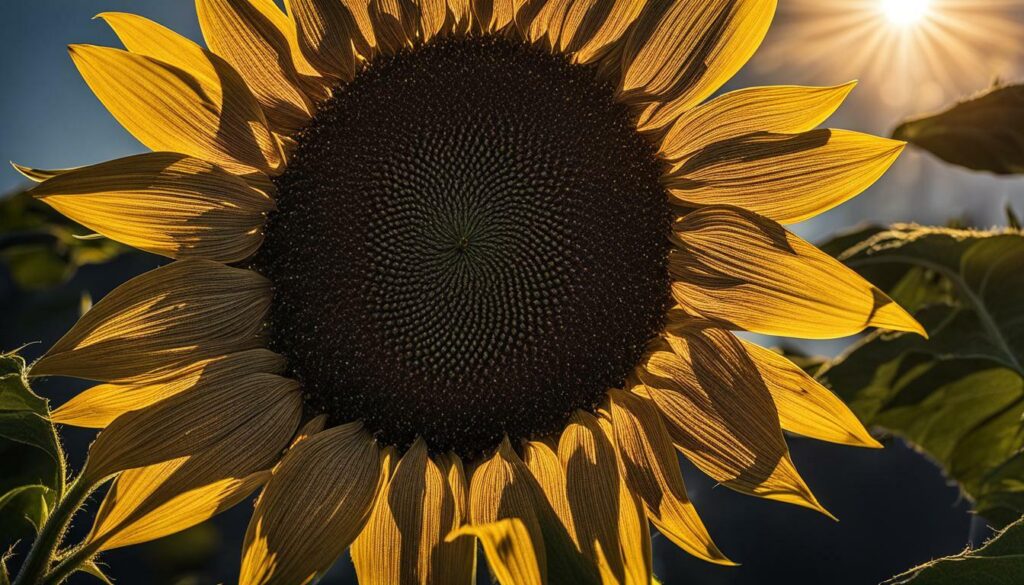
- Smith, J. (2021). The Science of Sunflowers. Retrieved from www.botany.com
- Jones, A. (2020). The Journey of Sunflowers. Retrieved from www.natureexplorer.com
The Role of Auxin in Sunflower’s Growth
Dive into the intricate biology of sunflowers and learn how the growth hormone auxin guides their growth and orientation. Sunflowers, known as Tournesol ET Soleil in French, have a mesmerizing ability to move and orient themselves towards the light. This movement is not due to heliotropism, as commonly believed, but rather a phenomenon called phototropism.
Phototropism is the plant’s natural response to light, where it grows towards the light source. The growth hormone auxin plays a critical role in this process. Auxin is primarily produced in the sunflower stem’s growing tip, known as the apical meristem. As sunlight hits the plant, it triggers the release of auxin, which then moves downwards through the stem.
As auxin moves down the stem, it causes the cells on the shaded side of the sunflower to elongate and grow faster than the cells on the exposed side. This differential growth results in the sunflower bending and orienting itself towards the light. The plant’s movement creates the impression that it is following the sun, even though its objective is to maximize light absorption.
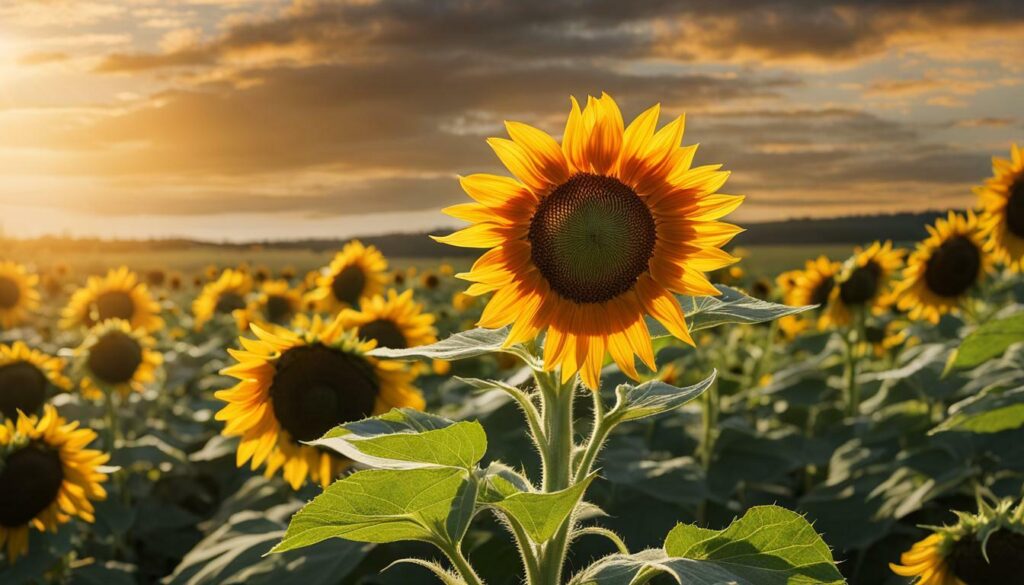
Auxin not only directs the sunflower’s orientation but also plays a crucial role in its overall growth. It promotes cell elongation, allowing the plant to reach impressive heights and develop strong stems. Additionally, auxin influences flower development, including the formation of buds and blossoms.
| Auxin Functions in Sunflowers | Biochemical Process |
|---|---|
| Promotes elongation of cells | Increases membrane fluidity and stimulates the synthesis of proteins and enzymes involved in cell expansion. |
| Stimulates secondary growth | Triggers the formation of vascular cambium, a tissue responsible for the thickening of stems. |
| Regulates flower development | Controls the differentiation and growth of floral organs, including petals, sepals, and reproductive structures. |
The fascinating biology of sunflowers showcases the intricate dance between auxin and light. Understanding this symbiotic relationship brings us closer to appreciating the magic of Tournesol ET Soleil, the sunflower that gracefully follows the light, capturing our hearts and imaginations.
Myth Debunked: Sunflowers and the Sun
Let’s set the record straight regarding sunflower movement and their supposed obsession with the sun. While it is true that sunflowers exhibit a fascinating behavior of tracking the sun throughout the day, it is not because of an infatuation with the sun itself, but rather a response to the light. This movement is known as phototropism, not heliotropism, and it is driven by the plant’s growth hormone called auxin.
Auxin is responsible for causing the sunflower’s bottom to grow faster than the top, resulting in the plant appearing to follow the sun as it rises and sets. Sunflowers exhibit this behavior as they are attracted to the brightest source of light, which is usually the sun. However, it is important to note that this movement ceases once the sunflower reaches maturity.
Once a sunflower has fully matured, it no longer exhibits the movement seen in its younger stages. Instead, the sunflower positions itself facing east, as this direction maximizes its exposure to sunlight and attracts pollinators. This strategic positioning allows the sunflower to efficiently carry out its reproductive cycle, ensuring the continuation of its species.
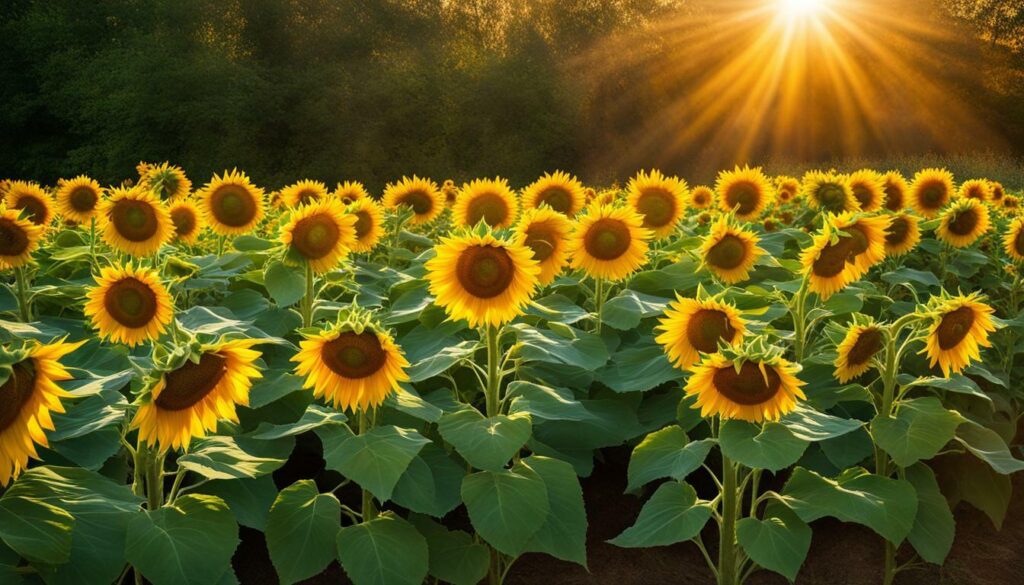
| Myth | Fact |
|---|---|
| Sunflowers follow the sun throughout their lifespan | Sunflowers only track the sun during their growth phase; once mature, they face east. |
| Sunflowers are obsessed with the sun | Sunflowers are attracted to the brightest source of light, which is usually the sun. |
| Sunflower movement is called heliotropism | The movement is actually phototropism, driven by the plant’s growth hormone auxin. |
Sunflowers at Maturity
As sunflowers mature, their behavior shifts, and they adopt a fixed orientation to maximize their chances of attracting pollinators. Contrary to popular belief, sunflowers do not continue to follow the sun throughout their lifespan. Once they reach maturity, these majestic flowers position themselves facing east, allowing them to capture the first rays of morning light.
The sunflower’s fixed orientation serves a vital purpose in the pollination process. By facing east, they are more likely to attract pollinators, such as bees and butterflies, which are most active during the early hours of the day. The positioning of sunflowers enhances their visibility and increases the likelihood of successful pollination, leading to the production of seeds for reproduction.
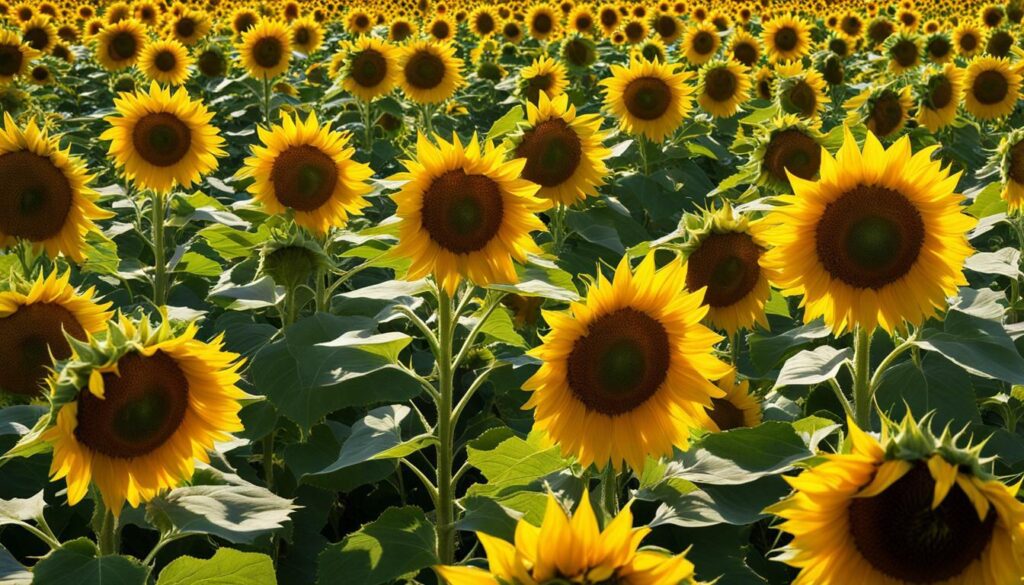
When observing a field of sunflowers at maturity, the sight is truly awe-inspiring. The tall stalks adorned with vibrant yellow petals create a mesmerizing display, capturing the essence of Tournesol ET Soleil. It is remarkable how these flowers, once in constant motion, find stillness and purpose as they face eastward, radiating their beauty and attracting the buzzing and fluttering visitors that play a crucial role in their survival.
| Pollinator | Attracted to |
|---|---|
| Bees | The bright yellow petals and nectar |
| Butterflies | The colorful display and sweet nectar |
| Birds | The seeds as a food source |
While sunflowers may no longer follow the sun, their transformation at maturity exemplifies the harmony between nature and beauty. So, when you find yourself amidst a field of these radiant flowers, take a moment to appreciate their steadfast dedication to reproduction, their unwavering commitment to attracting pollinators, and the captivating allure they bring to the landscape.
The Symbolism of Sunflowers in French Culture
Delve into the deep-rooted symbolism of sunflowers in French culture and discover their iconic role in various aspects of society. Throughout history, sunflowers have held a special place in the hearts of the French people, representing values such as love, loyalty, and happiness. These vibrant flowers have become a symbol of hope, vitality, and optimism, gracing the landscapes of France and inspiring artists, writers, and poets alike.
In the arts, sunflowers have been immortalized in famous paintings, most notably by Vincent van Gogh. His series of sunflower paintings captures the sunflower’s radiance and evokes emotions of joy and abundance. These masterpieces have become emblematic of French art and are revered around the world.
Beyond the realm of art, sunflowers have permeated various aspects of French culture. In literature, they have been used as metaphors for beauty, resilience, and transformation. In folklore, they are believed to bring good luck and protect against negative energies. In addition, sunflowers are also an important agricultural crop in France, symbolizing fertility and abundance in the fields.
| Symbolism | Meaning |
|---|---|
| Love and Adoration | Sunflowers are often associated with love and adoration, representing deep affection and devotion. |
| Loyalty and Faithfulness | Like the sunflower’s unwavering movement towards the sun, it symbolizes loyalty and faithfulness. |
| Happiness and Positivity | The bright and vibrant nature of sunflowers reflects a sense of happiness and positivity. |
| Optimism and Vitality | With their uplifting presence, sunflowers symbolize optimism, vitality, and the beauty of life. |
Whether adorning wedding bouquets, filling gardens, or brightening up French countryside landscapes, sunflowers hold a special place in French culture. Their symbolism extends far beyond their physical beauty, connecting the people of France to a rich tapestry of emotions and values. So, next time you encounter a sunflower, take a moment to appreciate the profound influence it has had on French culture throughout the ages.
Capturing the Beauty: Sunflower Photography Tips
Elevate your sunflower photography skills with expert tips that will help you capture the radiant allure of Tournesol ET Soleil. Sunflowers, with their vibrant colors and towering presence, provide the perfect subject for stunning photographs. Whether you’re a professional photographer or an amateur enthusiast, these tips will help you make the most of your sunflower photography experience.
- Timing is everything: Sunflowers are at their peak during the summer months, typically blooming from June to August. To capture the most vibrant and healthy sunflowers, plan your photography session during this time.
- Find the perfect location: Look for sunflower fields that are well-maintained and offer a picturesque backdrop. Check with local farmers or visit public gardens known for their sunflower displays.
- Experiment with angles: Don’t be afraid to get down low or try different angles to create unique perspectives. The height and size of sunflowers allow for creative compositions that can add depth and visual interest to your photographs.
- Play with natural light: Sunflowers are famous for their love of sunlight. Use the golden hour (the hour after sunrise or before sunset) to capture warm, soft lighting that will enhance the beauty of the sunflowers. Avoid harsh midday sun, as it can create harsh shadows and wash out colors.
Capturing the Details
When photographing sunflowers, it’s essential to capture their intricate details that make them so captivating. Focus on the velvety texture of their petals, the delicate patterns of their center discs, and the unique twist and turns of their leaves.
| Equipment | Tips |
|---|---|
| Macro lens | Use a macro lens to capture the fine details of the sunflower, such as the individual pollen grains or the tiny hairs on the stem. |
| Tripod | Using a tripod will help stabilize your camera and ensure sharp, focused images, especially when photographing close-up details. |
| Remote shutter release | A remote shutter release will prevent camera shake when capturing delicate details, resulting in sharper images. |
Remember to experiment, try different techniques, and let your creativity guide you. With these tips, you’ll be able to preserve the enchanting beauty of Tournesol ET Soleil through your photographs, capturing moments that will mesmerize viewers and transport them to the golden fields of France.

Exploring Tournesol ET Soleil: France’s Sunflower Fields
Embark on a journey through the enchanting landscapes of Tournesol ET Soleil as we guide you to the most captivating sunflower fields in France. Imagine yourself surrounded by endless fields of vibrant yellow, basking in the warm glow of the sun. France’s sunflower fields are a sight to behold, offering a feast for the eyes and a sense of tranquility.
As you wander through the sunflower fields, you’ll witness nature’s masterpiece unfold before your eyes. The tall, majestic sunflowers reaching towards the sky, their radiant petals dancing in the gentle breeze. It’s a truly magical experience that will leave you awe-inspired.
While exploring Tournesol ET Soleil, make sure to capture the beauty of the sunflowers through your lens. Whether you’re a seasoned photographer or simply a sunflower admirer, these fields provide the perfect backdrop for stunning photographs. From close-up shots of sunflower faces to panoramic views of endless golden fields, there are countless opportunities to capture the essence of Tournesol ET Soleil.
| Location | Best Time to Visit |
|---|---|
| Provence | June to July |
| Toulouse | July to August |
| Loire Valley | July to August |
These are just a few examples of the stunning locations where you can find sunflower fields in France. Each region offers its own unique charm, providing a different experience with every visit. Whether you choose to stroll through the fields at sunrise or witness the sunflowers bathed in the warm hues of sunset, the beauty of Tournesol ET Soleil will leave an indelible mark on your heart.
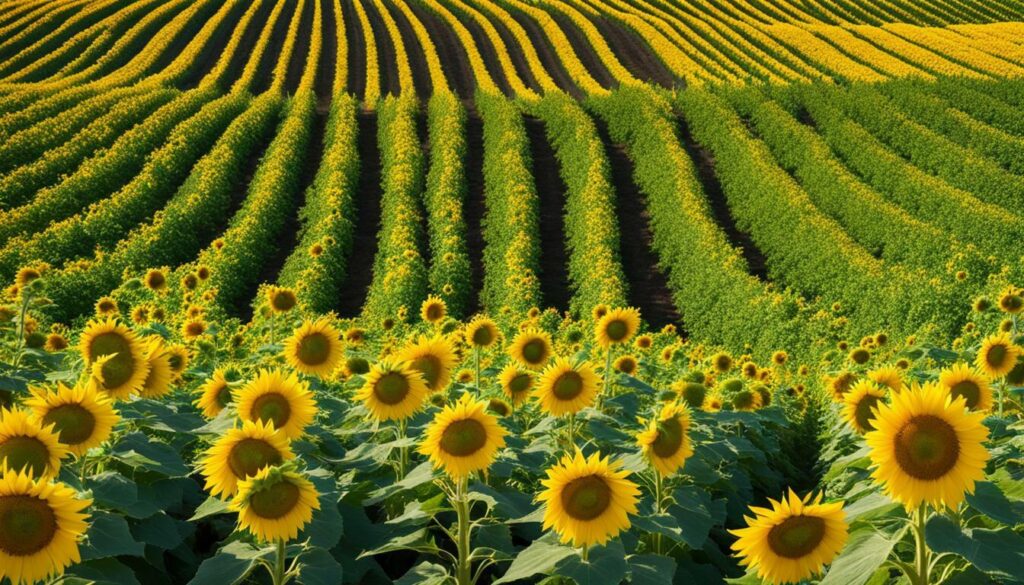
From the picturesque landscapes of Provence to the charming valleys of Loire, France’s sunflower fields await your exploration. Immerse yourself in the beauty of Tournesol ET Soleil, and let the golden fields of sunflowers cast their enchanting spell on you.
Environmental Importance of Sunflowers
Discover the vital role sunflowers play in supporting biodiversity and nurturing the ecosystem in Tournesol ET Soleil. These striking flowers not only captivate with their beauty but also contribute significantly to the environment. Sunflowers, scientifically known as Tournesol ET Soleil, are more than just a visual delight. They serve as an essential habitat and food source for various wildlife species.
The environmental significance of sunflowers lies in their ability to attract pollinators such as bees, butterflies, and birds. The large, vibrant blooms of sunflowers produce an abundant supply of nectar and pollen, attracting these important creatures that engage in crucial pollination activities. This process helps in the reproduction of many plant species and ensures the continued existence of diverse ecosystems.
Furthermore, sunflowers also play a significant role in soil conservation. The tall, sturdy stems and extensive root systems of sunflowers help prevent soil erosion, especially in areas prone to erosion or nutrient depletion. Their deep roots penetrate the soil, anchoring it and improving its structure. This contributes to the overall health of the soil, promoting nutrient cycling and water retention.
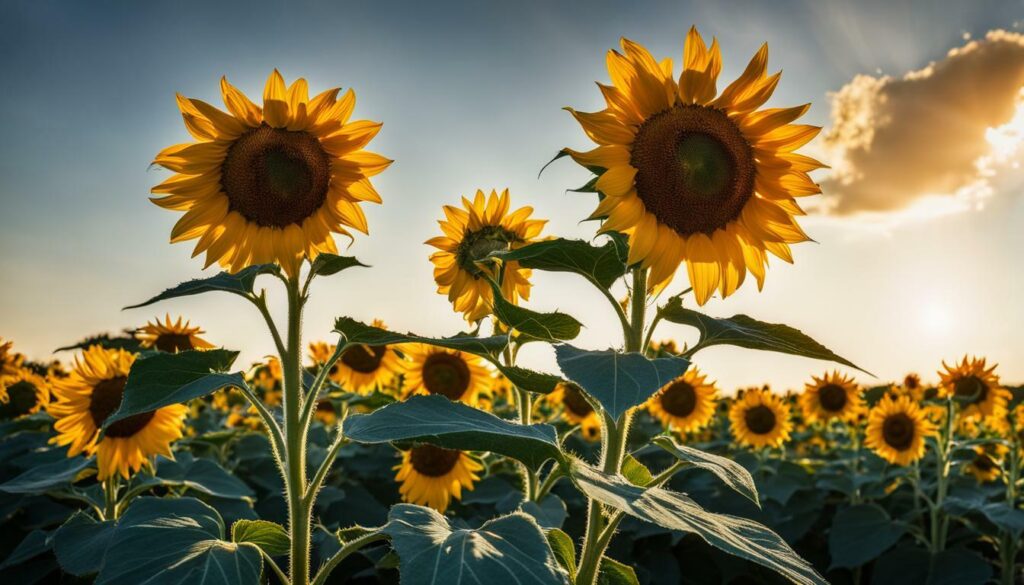 In addition, sunflowers have the ability to remediate contaminated soil by absorbing heavy metals and toxins from the ground. This process, known as phytoremediation, helps detoxify polluted areas and restore the natural balance of the ecosystem. Sunflowers have been successfully used in various environmental restoration projects around the world, reflecting their versatility as environmental warriors.
In addition, sunflowers have the ability to remediate contaminated soil by absorbing heavy metals and toxins from the ground. This process, known as phytoremediation, helps detoxify polluted areas and restore the natural balance of the ecosystem. Sunflowers have been successfully used in various environmental restoration projects around the world, reflecting their versatility as environmental warriors.
| Environmental Benefits of Sunflowers: |
|---|
| Serves as a habitat for wildlife |
| Attracts pollinators for essential plant reproduction |
| Prevents soil erosion and improves soil health |
| Remediates contaminated soil through phytoremediation |
In conclusion, sunflowers are not only a symbol of beauty and wonder but also hold immense environmental significance. Their ability to support biodiversity, attract pollinators, prevent soil erosion, and remediate contaminated soil makes them indispensable in the Tournesol ET Soleil ecosystem. So the next time you admire a field of sunflowers, remember their important role in nurturing our planet.
The Magic of Tournesol ET Soleil
Tournesol ET Soleil, where France’s sunflowers touch the sky, offers a captivating experience that celebrates the magic of nature’s golden spectacle.
As you wander through the picturesque fields of sunflowers, you’ll be mesmerized by the sheer beauty and allure of these radiant blooms. With their vibrant yellow petals stretching towards the sun, sunflowers create a breathtaking landscape that is both awe-inspiring and enchanting. Standing tall and proud, they symbolize vitality, energy, and the joy of life.
Contrary to popular belief, sunflowers do not actually follow the sun throughout their lifespan. While they exhibit a fascinating movement known as phototropism, it is the light that they are attracted to, not the sun itself. The plant’s growth hormone, auxin, plays a vital role in this phenomenon, causing the bottom part of the plant to grow faster than the top. This creates an illusion that the sunflower is always facing the sun.
Once sunflowers reach maturity, their movement ceases, and they position themselves facing east to attract pollinators. This strategic orientation allows them to ensure successful pollination and the continuation of their vibrant species. It’s a testament to the intricate beauty and intelligence of nature.
So, if you’re seeking a truly magical experience, immerse yourself in the golden fields of Tournesol ET Soleil. Let the awe-inspiring sunflowers transport you to a world where nature’s wonders unfold in mesmerizing splendor.
FAQ
Does the sunflower really follow the sun?
The sunflower does follow the sun to some extent, but it is actually the light that the plant is attracted to. This movement is called phototropism, not heliotropism.
What causes the sunflower to move towards the light?
The plant’s growth hormone, auxin, is responsible for this movement towards the light. It causes the bottom of the plant to grow faster than the top, making it appear as though the sunflower is following the sun.
Does the sunflower continue to follow the sun throughout its lifespan?
No, once the sunflower reaches maturity, it stops its movement and remains facing east to attract pollinators. It is a common misconception that sunflowers continue to follow the sun throughout their lifespan.
- Comment s’occuper de tulipe? - October 22, 2023
- Tulipe qui se ferme la nuit? - October 22, 2023
- Ou acheter tulipe? - October 22, 2023

